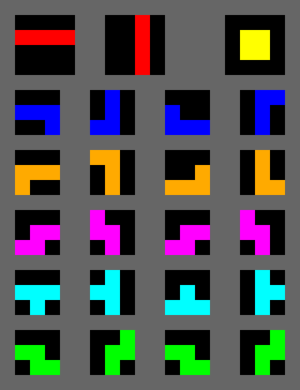Arika Rotation System
TGM rotation is a game play mechanic used in Tetris The Grand Master and other Arika tetromino games, derived from that of Sega's arcade Tetris game.
Colors
Games using TGM/Sega rotation generally uses the following color scheme (with the exception of Tetris the Grand Master Ace):
- I: red
- J: blue
- L: orange
- O: yellow
- S: purple
- T: cyan
- Z: green
Basic rotation

Tetrominoes start out centered, rounding to the left. I goes in columns 3–6 counting from the left, O in columns 4–5, and others in columns 4–6. Each tetromino starts with its topmost solid block in row 20 (or 22 in TGM ACE). Each tetromino is ordinarily spawned flat side up. However, if the player holds down a rotate button while the tetromino is being spawned, it is spawned rotated by one unit (Initial Rotation System).
Apart from I and O, all tetrominoes rotate such that the bottom of the tetromino is at the bottom of the piece's bounding box. S and Z rotate between two states so that the center column stays constant. O does not rotate; I rotates between two states as depicted in the illustration.
The primary difference between ARS and Nintendo Rotation System is that the flat-down states of J, L, and T are pushed down by one space.
Wall kick
- Illustration goes here.
Sometimes a rotation is blocked by the walls outside the playfield or by blocks inside the playfield. Most often, TGM tries to rotate the tetromino within the box without moving it, then try one space to the right, then try one space to the left, then fail. In some special cases, TGM skips one of these displacements. TGM2 and Sakura Tetris use the same system as TGM.
TGM3 also tries floor kick when rotating a T or I tetromino to some orientations.